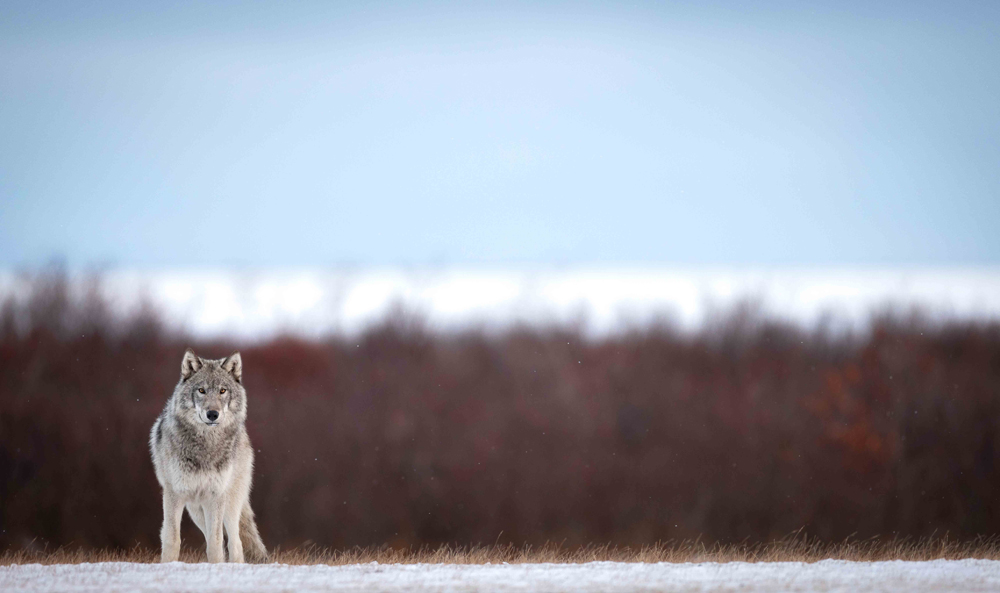There are trips that turn into films — my polar bear photo safari with Churchill Wild at Nanuk Polar Bear Lodge could have been written as a screenplay.
My name is Mathieu Courdesses, I am a wildlife photographer and wildlife documentary director. I have traveled the world to meet endangered animals. I had never photographed polar bears, but these animals embody the major conservation challenges that endangered animals face, and I wanted to photograph them in a unique environment. Churchill Wild was the obvious choice.
My journey begins in late October. I arrive in Churchill and get ready to board a small plane to Nanuk Polar Bear Lodge. I thought I would experience my first emotions when seeing my very first polar bear, but I was wrong, the flight over the ice floe is breathtaking. Frozen lakes and coniferous forests draw geometric lines on the tundra.
It’s an exceptional show. We land at Nanuk Polar Bear Lodge in this immense and hostile expanse of ice, in the middle of nowhere. Immediately we feel at home: the friendliness of the guides and managers gives us strength and energy after two days of travel (from Paris). The lodge is warm and friendly. The Nanuk team have managed to create a feeling of “home” in the middle of Nature, hundreds of kilometers from any city. Everything is done to make you feel comfortable, and it works!
In the morning and afternoon we look over the biodiversity of the region. If searches are unsuccessful, the landscapes are a welcome spectacle to behold. At the end of the second day our vehicle stops. Emri, our guide, takes his binoculars: he sees something. It’s not easy to find a polar bear in this great white desert, but our guides are experts. From more than a kilometer away, they are capable of spotting the smallest animal.
Emri confirms it to us: a bear is lying on the ice floe. It’s time to approach the purpose of our quest, on foot! Yes, on foot! The guides are trained to understand the behavior of bears, so we can approach them without putting ourselves in danger. Churchill Wild is the favorite place of the greatest wildlife photographers, thanks to this ease of photographing/filming polar bears at eye level.
We advance on a frozen lake and little by little I make out the silhouette of the bear, and he is looking at us. This is the first time in my life that I have seen a polar bear. Its massive silhouette is impressive. We stay about a hundred meters away. Then at the last ray of the sun, he will decide to get up and pass in front of a shaded sky with purple reflections. It’s a postcard, a painting in the ice floe.
The journey progresses and we see more and more interesting visuals with bears. Here on Hudson Bay, polar bears are passing through. Some of them see a human shape for the first time, and meeting the intrigued and curious look of the largest terrestrial predator on the planet is amazing. A bear eating the remains of a seal, a huge solitary male, a bear sinking into the thick fog of the icy bay, every day we have different sightings. But I’m missing one… the wolf. This emblematic predator is difficult to observe.
The day before our departure, the guides informed us that the planes could not take off. We have to stay two more nights. Will this unexpected event help me find the wolf? We take advantage of this change to continue our expeditions in the extreme cold. During our entire stay, we did not have the same sky or the same lights twice. As a photographer, I pay close attention to lights. Here on Hudson Bay, in the first minutes of the day, the sky blazes. He makes us believe that he will warm us up.
But the hours pass and the warm colors of the morning give way to icy pink then blue. Splendid. There are few regions in the world where a cloudy sky offers even more sumptuous landscapes. At the end of the day, heavy dark clouds cover the sky. In the distance, silhouettes are walking in our direction: three polar bears! On foot, and I see them moving in my direction: a mother and her two little ones. With their muzzle raised, they look at us for a few seconds to understand if we are a threat. Finally they will pass a few dozen meters from my objective. Locking eyes with this little family of bears will be an unforgettable memory.
Our bags are packed and our plane is finally ready to take off. But just before we leave, the guides knock on our door: “They’re here! The wolves are here! ” I take my camera, I leave my room, and I see them: 15 wolves wandering around the lodge. They will stay less than 10 minutes. A light snow falls from the sky, offering us a fabulous moment.
Before leaving, I didn’t think I would be so moved by this trip. Observing this wildlife wandering in a freezing and hostile environment causes an indescribable feeling. How do these animals manage to survive in this icy desert? Thanks to their efforts and professionalism, Churchill Wild and the Nanuk Polar Bear Lodge have succeeded in developing unique expertise for observing rare wildlife.
I will remember these few days in the land of bears and wolves for a very long time. A stay which, day by day, unfolded like the scenario of a film with twists and turns!
Thank you Churchill Wild.
About Mathieu Courdesses
Born March 2, 1994, Mathieu Courdesses is a French wildlife photographer. A graduate of ESCP Europe, he specializes in the photography of endangered animals. From the Mountain Gorilla in Rwanda to the Sumatran Orangutan to the Brown-maned Lion of the Kalahari Desert, this nature expert has learned to share his knowledge and raise awareness through his work as a guide in southern Africa. The strength of his photos lies in his work with light and his keen knowledge of the animal world. His photos are very little retouched, the conception of his work is not to make it beautiful but to be the witness of a natural event, a story, or just a light.
Follow Mathieu on Social Media
Mathieu’s website: https://mathieucourdesses.com/
Instagram: @mathieucourdesses
Tiktok: @mathieu.courdesses
Facebook: /mathieu.courdesses
Youtube: @mathieucourdesses















